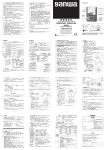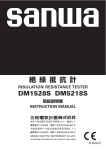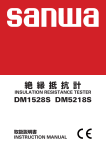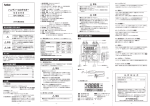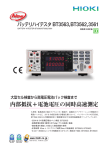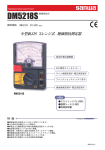Download 絶 縁 抵 抗 計 - Sanwa Electric Instrument Co., Ltd.
Transcript
【1】 安全に関する項目∼ご使用前に必ずお読みください∼ このたびは、電池式直流絶縁抵抗計をお買い上げいただき、誠にあ りがとうございます。 ご使用前にはこの取扱説明書をよくお読みいただき、正しく安全に ご使用ください。そして常にご覧いただけるように製品と一緒にして 大切に保管してください。 なお、取扱説明書での説明以外の使い方をしますと、本器に与えら れた保護が損なわれることがありますのでご注意ください。 ・・・ ・・ および “ 注意” の記載事項は、やけどや感電など 本文中の “ 警告” の事故防止のため、必ずお守りください。 1-1 警告マークなどの記号説明 本器および『取扱説明書』 に使用されている記号と意味について ・・・ ・・ ・警告文はやけどや感電などの人身事故を防止するためのものです。 ・注意文は本器を壊すおそれのあるお取扱いについての注意文です。 :安全に使用するための特に重要な事項を示します。 :高電圧が印加され危険なため触らないでください。 ACV :交流電圧 MAX600 V:最大定格電圧は600 V 1-2 安全使用のための警告文 警 告 ・・・ ・・ 以下の項目は、やけどや感電などの人身事故を防止するためのも のです。本器をご使用する際には必ずお守りください。 1 . 大電力または高電圧ラインでは使用しないこと。 2 . AC 33 Vrms (46.7 Vpeak) またはDC 70 V以上の電圧は人体に危険 ですので注意すること。 3 . 絶縁抵抗測定時は被測定物の電源を切り離すこと。 4 . 絶縁抵抗測定時は高電圧を発生するため感電に注意のこと。 5 . 感電事故防止のため、絶縁抵抗測定後は必ず被測定物に充電さ れた高電圧を放電すること。 6 . 最大定格入力値(1-3 参照) を超える信号は入力しないこと。 7 . 最大定格入力値を超える場合があるため、誘起電圧、サージ電 圧の発生する(モータなど) ラインの電圧測定はしないこと。 8 . 本体やテストリードに損傷がある場合は使用しないこと。 9 . ケースや電池ぶたをはずした状態では使用しないこと。 10. 感電防止のため測定用リードのつばより先を持たないこと。 11. 12. 13. 14. 15. 16. 17. 18. 1-3 ファンクション ACV DCV MΩ、BATTERY CHECK ・ファンクションスイッチ、MΩ (絶縁抵抗)測定スイッチ この2つのスイッチの切換えにより、次のようにファンクションやレ ンジが設定できます。 MΩ測定スイッチ(*) 設定レンジ(ファンクション) DM1528Sの場合 OFF AC 600 Vレンジ DM5218Sの場合 1000 V/2000 MΩレンジ 500 V/1000 MΩレンジ ON 250 V/500 MΩレンジ DM5218Sの場合 125 V/200 MΩレンジ DC 60 Vレンジ OFF BATTERY CHECK レンジ ON *MΩ測定スイッチは次 の操作でON(入)とな ります。 左端を引き起こす 右端を押す 大阪営業所=大阪市浪速区恵美須西2 - 7 - 2 郵便番号=556-0003・電話=大阪 (06) 6631-7361(代) 2-2 特 長 ・絶縁抵抗計の改訂JIS C1302-2002に準拠しています。 5-1 植物油インキを使用しています。 始業点検 警 告 1. 破損のある本体やテストリードを使用しての測定はしないこと。 2. テストリードが断線してないことを確認すること。 3. テストリードの断線テスト中、測定端子には高電圧が発生してい るので、感電に注意すること。 4. 感電、電池消耗防止上、測定終了後はMΩスイッチ・レバーおよ び、ファンクションスイッチつまみを必ずOFF位置にすること。 測定の前に [外観] [指針0位置][内蔵電池] [測定用リード] の順序で点 検を行います。 (*指針0位置とは、DC 60 V目盛の0目盛位置またはMΩ 目盛の∞目盛位置) 内蔵電池を 交 換してく ださい。 7-4電池交 換の項参照 内蔵電池の点検 外観の点検と指針0位置の確認 そのまま使 用せず修 理を依頼し てください。 ファンクションスイッチつまみをDC 60 V/ BATTERY CHECKに合わせます。 MΩ測定スイッ チをONにする。 指針が電池良 否判定目盛(BATT)から左にはずれ ていますか? はい いいえ ファンクションスイッチ、MΩ測 定スイッチをOFFにする。 プッシュスイッチをはなし、テストリードを新し いものと交換して再確認してください。交換 しても同じ状態の場合は修理が必要です。 指針が絶縁抵抗目盛の0 MΩ 目盛線に接していますか? ファンクションスイッチをAC 600 V・ 250 V/500 MΩに合わせます。 はい MΩ測定スイッチ、 ファンクション スイッチをOFFにします。 MΩ測定スイッチをONにします。 正常です。 各測定の項へ進んでください。 − 4 − 警 V レンジのときの目盛 ( 500 1000 MΩ) ( ( ) ) 注 意 正弦波以外の波形や、50∼60 Hz以外の周波数の交流では指示誤差を 生じます。 5-4 ディスチャージ (放電) 機能について 1) 安全のためにディスチャージが必要な理由 絶縁抵抗測定後にコンデンサや電線などの容量性の被測定物に残 る高電圧を放電させ事故を防ぎます。 2) ディスチャージの方法 前項 (5-3 4)の⑧) に続いて行います。 ① MΩ測定終了後、テストピンおよびクリップは被測定物に接続 したままで、MΩ測定スイッチのみをOFFにします。 ② このときメータの指針は右方向に振れ、その振れは時間ととも に小さくなります。 (充電されていた電荷が放電していることを 示す) ③ 指示が零 (MΩ目盛の∞)となり、ディスチャージ(放電)が完了 したら、前項5-3 4)の⑩⑪の操作を行います。 1) 測定対象 電灯線電圧などの正弦波交 流電圧(ACV)が測定できま す。 2) 測定方法 ① クリップ付きリード (黒) を 接地側測定端子に、テス トピン付きリード (赤) をラ イン側測定端子に差し込 みます。 ② ファンクションスイッチ つまみをAC 600 V ( 3つの MΩレンジの いずれか)に 合わせます。 ③ 被測定回路の接地側にクリップ付きリードを、充電側(ライン 側) にテストピン付きリードをそれぞれ接続します。 ④ ACV目盛にて指示を読み取ります。 ⑤ 被測定物から、テストピン付きリード、クリップ付きリードの 順にそれぞれはずします。 ⑥ ファンクションスイッチつまみをOFF位置にします。 − 8 − − 9 − 〔DM5218Sの場合〕 ⑩ まず被測定物からテストピン付きリードのテストピンを離し、 次にクリップ付きリードのクリップをはずします。 ⑪ ファンクションスイッチつまみを必ずOFF位置にします。 7-4 電池交換 警 告 1. 測定端子に入力を加えた状態でリヤケースや電池ぶたをはずす と、感電のおそれがあります。 2. 高電圧の発生防止のため、MΩ測定スイッチおよびファンクショ ンスイッチつまみをOFFの位置にしてから電池交換すること。 ねじ 電池ぶた スナップ端子 㸝9㸞 6LR61電池(6LF22) 電池は必ず積層型アルカリ乾電池6LR61形(6LF22)をご使用ください。 【8】アフターサービスについて 8-1 保証期間について 本製品の品質保証期間は、お買い上げの日より3年間です。 ただし、日本国内で購入し日本国内でご使用いただく場合に限りま す。また、製品本体の許容差は1年保証、製品付属の電池、テスト リード等は保証対象外とさせていただきます。 8-2 修理およびお問い合わせについて 1) 修理依頼の前に次の項目をご確認ください。 ・内蔵電池の容量はありますか?電池装着の極性は正しいですか? ・測定用リードは断線していませんか? 2) 保証期間中の修理 ・保証書の記載内容によって修理させていただきます。 3) 保証期間経過後の修理 ・修理によって本来の機能が維持できる場合、ご要望により有料で 修理させていただきます。 ・修理費用や輸送費用が製品価格より高くなる場合もありますので 事前にお問い合わせください。 ・本品の補修用性能部品の最低保有期間は、製造打切後6年間です。 補修用性能部品保有期間を修理可能期間とさせていただきます。 購買部品の入手が製造会社の製造中止等により不可能になった場 合は、保有期間が短くなる場合もありますのでご承知ください。 4) 修理品の送り先 ・製品の安全輸送のため、製品の5倍以上の容積の箱にテストリード も一緒に入れ、十分なクッションを詰め、お送りください。 ・箱の表面に「修理品在中」 と明記してください。 ・輸送にかかる往復の送料はお客様のご負担とさせていただきます。 [送り先] 三和電気計器株式会社・羽村工場サービス課 554-0113 〒205-8604 東京都羽村市神明台4-7-15 TEL(042) ・お問い合わせ 東京本社 :TEL (03) 3253-4871 FAX(03) 3251-7022 大阪営業所 :TEL (06) 6631-7361 FAX(06) 6644-3249 三和電気計器(株)ホームページ:http://www.sanwa-meter.co.jp お客様計測相談室 0120-51-3930 受付時間 9:30∼12:00 13:00∼17:00 (土日祭日を除く) 【9】仕 様 9-1 一般仕様 AC整流方式 :半波整流方式 (平均値指示実効値換算) メータ仕様 :内磁型トートバンド方式、24 μA 電池消耗表示 :BATTERY CHECKレンジにて確認 許容差保証温湿度範囲 :23±5 ℃ 75 %RH以下 結露のないこと 使用温湿度範囲 :0∼43 ℃ 80 %RH以下 結露のないこと 保存温湿度範囲 :−10∼50 ℃ 70 %RH以下 結露のないこと 使用環境条件 :高度2000 m以下 環境汚染度Ⅱ 電源 (内蔵電池):積層型アルカリ乾電池6LR61 (6LF22) 1本(9 V) 適合規格 IP保護等級 EMC 安全規格 − 13 − 定格測定電圧 250 V、500 V、1000 V 125 V、250 V、500 V − 6 − − 7 − 4. 5. 6. 注 意 1. 被測定物が接地(アース)されているときには、通常接地側にク リップ付きリード (EARTH) を、回路側へテストピン付きリード (LINE) を接続します。 (このように接続した方が、逆に接続した 場合より一般に小さな値となる) 2. 測定誤差を防止するため、LINE側に接続したテストリードは、 被測定物や大地になるべく触れないようにして測定します。 3. 絶縁抵抗は、温度や湿度によって大きく変化します。印加する電 圧 (測定電圧) によっても変化します。一般に温度、湿度、電圧が それぞれ高い程、絶縁抵抗値は低くなります。 5-6 DCV (直流電圧)の測定 (測定レンジはDC 60 Vレンジのみ) 警 告 1. 最大定格入力値DC 60 Vを超えた電圧を加えないこと。 2. その他、前項(5-5)の警告と同様の注意をすること。 1) 測定対象 バッテリーなどの直流電圧の測定ができます。 また、MΩ測定前に被測定回路の直流電圧の有無のチェックにも 使えます。 2) 測定方法 ① クリップ付きリード (黒) を接地側測定端子に、 テストピン付きリード (赤)をライン側測定端 子に差し込みます。 ② ファンクションスイッチ つまみを DC 60 V/BATTERY CHECKに合わせ ます。 ③ 被測定物(回路)の−側 にクリップ付きリード (黒)を、+側にテスト ピン付きリード(赤)を それぞれ接続します。 ④ DCV目盛にて指示を読 み取ります。 ⑤ 被測定物から、テストピ ン付きリード、クリップ 付きリードの順にそれぞ れはずします。 ⑥ ファンクションスイッチつまみをOFF位置にします。 首掛けで 使用時 【6】携帯ケースの使い方 測定時に は、図のよ うにセット し、首に掛 けてご使用 ください。 本体固定用 バンド ・ふたは 方向にA 点 を支点に回 転する。 ・更に箱の底 部に添わ せ 、*印 の ホックで 結 合する。 本体入れ 部分 手提げで 携帯する時 テストリード 入れ部分 ホックで 結合 A * * フックで結合 【7】保守管理について 警 告 1. 安全上重要項目です。説明書をよく理解して管理を行うこと。 2. 安全と確度の維持のため1年に1回以上は校正、点検を実施すること。 7-1 保守点検 (5-1 始業点検 を参照してください) 1) 本 体 の 外 観 :落下などにより、外観が壊れていないか? 2) 測定用リード :コード部分が傷んでいないか? :芯線などの導電部分が露出していないか? 以上に該当する場合は使用を中止し、修理または新しいものと交換 してください。 7-2 校 正 :校正、点検は製造元でも行っております。 7-3 保管について 注 意 1. パネル、ケースなどは揮発性溶剤に弱いため、シンナやアルコー ルなどで拭かないこと。軟らかい布などで軽く拭き取ること。 2. パネル、ケースなどは熱に弱いため、熱を発するもの (はんだこ てなど) の近くに置かないこと。 3. 振動の多い所や落下のおそれがある所には保管しないこと。 4. 直射日光下や高温または低温、多湿、結露のある場所では保管し ないこと。(9-1項の保存温湿度範囲参照) 5. 長期間使用しない場合は内蔵電池を必ず抜くこと。 − 10 − − 11 − *過電圧カテゴリ (CAT.Ⅲ):直接、分電盤から電気を取り込む機器の 一次側および分岐回路からコンセントまでの電路。 耐 電 圧 寸法・質量 付 属 品 :AC 3.7 kV (1分間) 、測定端子∼リヤケース間 :144(H ) ×99(W ) ×43(D) mm、約310 g :テストリードTL-508Sa 1セット 携帯ケースC-08S 1、取扱説明書 1 9-2 測定範囲および許容差 許容差保証範囲:23±5 ℃ 75 %RH以下 姿 勢:水平±5° 以内 機種名 DM1528S 保証書 ご氏名 500 V 1000 MΩ 250 V 500 MΩ ご住所 結露のないこと 0.5−1−500 −1000 MΩ 0.1−0.5−200 −500 MΩ 250 V 500 MΩ 0.1−0.5−200 125 V 200 MΩ 0.05−0.2−100 0∼600 V 直流電圧 レンジ (DCV) 0∼60 V 名 '06'06 製造No. この製品は厳密なる品質管理を経てお 届けするものです。 本保証書は所定項目をご記入の上保管 していただき、アフターサービスの際 ご提出ください。 ※本保証書は再発行はいたしませんの で大切に保管してください。 〒 DM5218S 交流電圧 レンジ (ACV) 許 容 差 型 様 定格測定電圧 太字:第1有効目盛 定格測定電圧 太字:第1有効目盛 絶縁抵抗 最大目盛値 細字:第2有効目盛 最大目盛値 細字:第2有効目盛 レンジ 1−2−1000 0.5−1−500 1000 V 500 V (MΩ) −2000 MΩ 1000 MΩ −1000 MΩ 2000 MΩ 工場出荷時にモニター用電池が組み込まれておりますので、記載された電池 寿命に満たないうちに切れることがあります。 モニター用電池とは製品の機能や性能をチェックするための電池のことです。 :約2.6 W (1000 V/2000 MΩレンジのとき) :500回 (1回の測定時間を、5秒間 ON/25秒間 OFF とし、定格測定電流を流す値の抵抗器を接続、定 格電圧を維持できる測定回数) :JIS C1302-2002 絶縁抵抗計 に準拠 :IP20 :EN61326 :EN61010-1過電圧カテゴリⅢ600 V (CAT.Ⅲ* 600 V) 機 種 名 DM1528S DM5218S 参 考 1. 本器の定格測定電流は1 mA(1 mA∼1.2 mA) です。 (定格測定電圧/1 mA 以下の抵抗で、かつ第1有効測定目盛内の値 の抵抗を測定したとき1 mA∼1.2 mA以内) 2. 無負荷電圧は定格測定電圧の1.3倍以内です。 3. 測定の際、発振音が聞こえても故障ではありません。 1. 2. 3. ※出荷時の電池について 最大消費電力 測定可能回数 (電池寿命) 1) 測定対象 電気機器や回路の絶縁抵抗 (MΩ)測定 2) 定格測定電圧 3) 測定レンジの選択 絶縁抵抗の測定では、特に指定のない限り、被測定回路の使用電 圧になるべく近い電圧のレンジを選びます。 例えば、100 Vの家電製品や屋内配線の絶縁抵抗測定では、125 Vの 定格測定電圧のレンジを、200 Vの動力回路の測定では、250 Vの定 格測定電圧のレンジを選びます。 4) 測定方法 ① 被測定物の電源を切ります。 ② クリップ付きリード(黒)を接地側測定端子(EARTH)へ、テス トピン付きリード(赤)をライ ン側 (LINE) 測定端子に差し込 みます。 ③ ファンクションスイッチつま みを目的の定格測定電圧のレ ンジに合わせます。 ④ 被測定物にクリップ付きリー ドのクリップを接続します。 通常は接地側測定端子を接地 線側とします。 ⑤ 被測定物のもう一方にテスト ピン付きリードのテストピン を接触させます。 注. この状態 (MΩ測定スイッ チOFF)でメータが振れ る場合は、被測定物が活 線状態です。(電圧が加 わっている)必ず、電圧 がない状態にしてから測 定してください。 ⑥ MΩ測定スイッチをON(入) に します。(“【4】機能説明”の項 を参照) 警 告 MΩ測定レンジのとき、測定端子には電圧を絶対に加えないこと。 被測定物 (回路)の電源を切り離してから測定すること。 被測定回路に電圧が加わってないことを、AC 600 V レンジなどで 確認してから測定をすること。 測定中は本器から高電圧を発生するため、テストピンやクリッ プ、および被測定物には手を触れないこと。 測定直後は、本器および被測定回路が高電圧で充電されているの で感電に注意すること。 感電事故のおそれがあるため、測定後は必ず被測定物に充電され た高電圧を放電すること。 ( 「5-4 ディスチャージ」 の項参照) 告 1. 最大定格入力値AC 600 Vを超えた電圧を加えないこと。 2. 測定中はファンクションスイッチつまみを切り換えないこと。 3. MΩ測定スイッチを押したり、引き起こした状態で電圧測定をし ないこと。 4. ブレーカ付きの被測定回路では、その2次側 (負荷側) で電圧の測 定をすること。 5. 感電防止のためテストリードのピンプラグや、クリップの金属部 に手を触れないこと。 − 3 − 内蔵電池の点検は5秒以上続けないこと。 5-3 MΩ (絶縁抵抗)の測定 − 5 − 5-5 ACV (交流電圧)の測定 (測定レンジはAC 600 Vレンジのみ) 16 -1201 2040 2040 5-2 内蔵電池の点検 (BATTERY CHECK) MΩ (絶縁抵抗) 測定の前には、内蔵電池の点検 (前項5.1参照) を必ず 行ってください。電池が消耗していると測定誤差の原因となるだけでな く、誤測定により危険です。 点検方法は 「5-1 始業点検」 を参照してくだ さい。 (電池は必ず積層型アルカリ乾電池6LR61形をご使用ください) 点検スタート 破損がある 本体および 測定用リードの外観に破損は ありますか? 本書に掲載した製品の仕様や外観は改良等の理由により、予告なし に変更することがありますのでご了承ください。 Dempa Bldg,Sotokanda2-Chome Chiyoda-Ku,Tokyo,Japan いいえ 250 V 500 MΩ レンジのときの目盛 125 V 200 MΩ レンジのときの目盛 ファンクションスイッチつまみ 取扱説明書 INSTRUCTION MANUAL SANWA ELECTRIC INSTRUMENT CO.,LTD. テストピンをクリップではさみます。 (ショートする) − 12 − DM1528S DM5218S 郵便番号=101-0021・電話=東京 (03) 3253-4871(代) クリップ付リードをEARTH端子に、テスト ピン付リードをLINE端子に接続します。 ⑦ 指示を読み取ります。 ファンクションスイッチつまみの位置 (設定レンジ)により専用 の目盛を使用します。 ⑧ MΩ測定スイッチをOFFにします。 ⑨ 被測定物に充電された高電圧を放電させます。 (5-4項を参照) 接地側測定端子・ 電圧測定端子 (− ∼) INSULATION RESISTANCE TESTER 2-1 用 途 ・本器は低電圧電線路や機器の絶縁抵抗測定用直流絶縁抵抗計です。 測定用リードの断線点検 ・メータ零位調整器 ファンクションスイッチがO F F の位置のとき、メータの指針が MΩ目盛 (スケール) の∞目盛線からはずれていれば、マイナスねじ 回しで回し合わせます。 ライン側測定端子・ 電圧測定端子 (+ ∼) 本社=東京都千代田区外神田2 -4-4 ・電波ビル 本体を水平に 置き指針0位調 いいえ 整器をマイナス 本体を水平 ドライバで回し に置いた状態で指針は0位置 指針を0位置に ですか? 合わせます。 はい レバーの右端を指 で押したときだけ ON (離すとOFF) ② レバーの左端を引 き起こしたとき連 続 で O N( 倒 す と OFF) BATTERY CHECK (内蔵電池良否判定)目盛 ダイヤル プレート 絶 縁 抵 抗 計 【2】用途と特長 破損なし ① DCV(直流電圧60 V) 目盛 MΩ (絶縁抵抗) 測定スイッチ ・レバー 最大定格入力値 最大過負荷保護入力値 AC 600 V AC 720 V DC 60 V DC 120 V 電圧・入力禁止 * DM1528Sの場合 ACV(交流電圧600 V)目盛 メータ零位 (0位)調整器 最大過負荷保護入力値 (AC電圧はサイン波の実効値で規定) 【5】測定方法 ① 電池ぶた取付けねじを2本は ずします。 ② スナップ端子に取り付けられ ている消耗した電池を、新し い電池と交換します。 ③ 電池を元の位置に収納し、電 池ぶたをねじ止めします。 MΩ(絶縁抵抗)目盛 メータ指針 − 2 − 【4】機能説明 1000 V/2000 MΩ 500 V/1000 MΩ AC 600 V 250 V/500 MΩ 125 V/200 MΩ 1000 V/2000 MΩ 500 V/1000 MΩ AC 600 V 250 V/500 MΩ 125 V/200 MΩ DC 60 V・BATTERY CHECK DC 60 V・BATTERY CHECK 裏面に電池ぶたがある (ねじ止め2本 ) 注 意 1 . 絶縁抵抗測定時、本器の測定端子には高電圧が発生しています。 耐電圧が、低かったり不明の機器及び部品 (半導体など) の接続 されている電路 (回路) では、破損防止上それ等を電路より外して 測定することをお奨めします。 特にコンピュータは要注意です。 2 . 絶縁抵抗測定では、被測定回路の使用電圧になるべく近い定格 測定電圧の絶縁抵抗計で測定してください。 例 100 Vの電路では定格測定電圧125 Vの絶縁抵抗計を用いる。 3 . 強力な電磁界、静電界のある場所での測定、インバータなど高 調波を多量に含む回路の測定では誤動作することがあります。 − 1 − ファンクションスイッチの位置 【3】各部の名称 測定中は他のファンクションに切り換えないこと。 本器または手が水などでぬれた状態では使用しないこと。 指定タイプのテストリードを使用すること。 テストリードは被測定物の接地側へ先に接続し、はずす場合は ライン側を先にはずしてから接地側をはずすこと。 電池交換を除く修理・改造は行わないこと。 始業点検および年1回以上の点検は必ず行うこと。 屋内で使用すること。 MΩファンクションの連続測定時間:本器の部品加熱防止上、 でき るだけ短時間で測定し、特に抵抗値が0 MΩ∼中央目盛値の時には 20秒以内とする。 更に、 20秒間測定した時は次の測定まで20秒間休 止、 5秒間測定した時には次の測定まで5秒間休止すること。 TEL 保証期間 ご購入日 年 本社=東京都千代田区外神田2−4−4・電波ビル 郵便番号=101-0021・電話=東京(03)3253−4871㈹ 月より 3 年間 −500 MΩ −200 MΩ 保証規定 保証期間中に正常な使用状態のもとで、万一故障が発生した場合には無償で修理いたします。 ・絶縁抵抗(MΩ) 第一有効測定範囲:指示値の±5 %以内 第二有効測定範囲:指示値の±10 %以内 0、∞目盛 :目盛長さの±0.7 %以内 無負荷電圧 :定格測定電圧の−0 %∼+30 %以内 定格測定電流 :1∼1.2 mA以内 短絡電流 :2.9 mA以下 ただし下記事項に該当する場合は無償修理の対象から除外いたします。 記 1. 取扱説明書と異なる不適当な取扱いまたは使用による故障 2. 当社サービスマン以外による不当な修理や改造に起因する故障 3. 火災水害などの天災を始め故障の原因が本計器以外の事由による故障 4. 電池の消耗による不動作 5. お買上げ後の輸送、移動、落下などによる故障および損傷 6. 本保証書は日本国において有効です。 This warranty is valid only within Japan. 年 月 日 修理内容をご記入ください。 ・交流電圧(ACV) 最大目盛値の±5 %以内 (正弦波交流:50∼60 Hz) ・直流電圧(DCV) 最大目盛値の±5 %以内 − 14 − ※無償の認定は当社において行わせていただきます。 【1】Read First: Safety Information We thank you for your purchasing our product, the battery-driven insulation resistance tester. This is a DC resistance tester developed under the principle to provide new and unique design and function for the measurement of insulation resistance of each kind of electric equipments. Since this tester generates high voltage, we recommend that you read this instruction manual thoroughly, and treat the tester correctly and safely. The symbols used on this tester and in this instruction manual denote the following meanings: Be careful as the high voltage is impressed. Be careful because there is a possibility of bodily injury or the destruction of equipment. WARNING DM1528S DM5218S INSULATION RESISTANCE TESTER INSTRUCTION MANUAL Dempa Bldg., Sotokanda 2-Chome Chiyoda-Ku, Tokyo, Japan 【5】Description of Functions ・Function control knob and MΩ(insulation resistance) measuring switch by operating these two switches, the functions and ranges can be set as shown below. Position of Function Control Knob MΩ Measuring Switch (*) 1000 V/2000 MΩ 500 V/1000 MΩ AC 600 V 250 V/500 MΩ 125 V/200 MΩ 1000 V/2000 MΩ 500 V/1000 MΩ AC 600 V 250 V/500 MΩ 125 V/200 MΩ DC 60 V・BATTERY CHECK DC 60 V・BATTERY CHECK Set Range (Function) DM1528S OFF 600 VAC range To ensure that the meter is used safely, follow all safety and operating instructions. 11. Never use tester for high power or high voltage circuit. 12. Pay special attention when measuring the voltage of AC 33 Vrms (46.7 V Peak) or DC 70 V or more to avoid injury. 13. Disconnect power source of the measured circuit before measuring insulation resistance. 14. High voltage is generated while measuring insulation resistance. Be cautions of electric shock. 15. After measuring insulation to avoid electric shock. Be sure to discharge the high voltage charged. 16. Never apply an input signal exceeding the maximum rating input value. 17. Never use tester for measuring the line connected with equipment (i.e. motors) that generates induced or surge voltage since it may exceed the maximum allowable voltage. 18. Never use tester if the tester or test leads are damaged or broken. 19. Never use uncased tester. 10. Always keep your fingers behind the finger guards on the probe when making measurements. Maximu rating input value AC 600 V DC 60 V Body securing band Body compartment To carry while held by hand Test lead compartment Pointer 0 position adjuster Earth side measuring terminal (EARTH) Function control knob 【4】Storage CAUTION ・The panel and the case are not resistant to heat. Do not place the instrument near heat-generating devices (such as a soldering iron). ・Do not store the instrument in a place where it may be subjected to vibration or from where it may fall. ・For storing the instrument, avoid hot, cold or humid piaces or places under direct sunlight or where condensation is anticipated. 2.2 Features ・This tester is based on the revised standard JIS C1302-2002 Insulation resistance testers. ・It is equipped with the discharge function. ・It is equipped with the MΩ (insulation resistance) measuring switch that enables both one-shot and continuous measurement. ・It can measure DC voltage and AC voltage. − 3 − 6.3 Measurement of MΩ (Insulation Resistance) WARNING 1. Never apply a voltage to the measuring terminal when the tester is in the MΩ measuring range. 2. Prior to measurement, disconnect the measuring object (circuit) from the power supply. 3. Prior to measurement, make sure no voltage is applied to the circuit to measure by the AC 600 V range. 4. During measurement, a high voltage is generated. Do not touch the test pin, clip and measuring object. 5. The tester and measured circuit have been charged by high voltage immediately after the measurement. Be careful not to get electric shock. 6. There is a possibility of an accident of electric shock. After the measurement, be sure to discharge the high voltage charged in the measuring object. (See 6.4 Discharge Function) Check start. Replace battery. See 7.4 Battery Replacement. Check built-in battery. Check appearance and pointer 0 position. Damaged Main unit and Stop using. test lead damaged Repair it. in appearance? Place main unit No damaged horizontally, No adjust pointer 0 position adjuster Pointer at 0 position with screwdriver when main unit is placed to bring pointer horizontally? to 0 position. Yes Turn function control knob to DC 60 V/BATTERY CHECK. Turn on MΩ switch. Pointer is on left of battery check scale(BATT)? Yes No Turn function control knob and MΩ switch to OFF. Check measuring lead wiring breakage. Release push switch and replace test lead with new one and re-check. If replacement does not work, repair Connect lead with clip to EARTH terminal and lead with test pin to LINE terminal. CAUTION No Clamp test pin with clip (to short). 1. When the measuring object is grounded (earth), a normal practice is to connect the lead with clip (EARTH) to ground (earth) and the lead with test pin (LINE) to the circuit. (When this connection is used, a measurement value becomes smaller than a value obtained by the reverse connection.) 2. To prevent a measuring error, keep the test lead connected to the LINE side out of contact with the measuring object and ground (earth). 3. The insulation resistance varies largely depending on temperature and humidity. It is also influenced by a voltage to apply (measuring voltage). Normally as temperature, humidity and voltage increase, the insulation resistance decreases. Pointer is at almost 0 MΩ position of insulation resistance scale ? Join by hook Turn function control knob to AC 600 V・250 V/500 MΩ. Raise left end Press right end Yes Turn MΩ measuring switch and function control knob to OFF. Turn on MΩ measuring switch. 【6】Measuring Method Normal. Proceed to measurement. 6.1 Start-up Check WARNING ・Meter zero position adjustment If the meter pointer is not on the ∞ graduation line of the MΩ scale when the function control knob is at OFF, adjust the zero position with a screwdriver. − 4 − REFERENCE 2) Measuring object Measurement of insulation resistance (MΩ) of electric equipment and circuits. Rated measuring voltage Model DM1528S DM5218S 6.2 How to Check Bult-in Battery (BATTERY CHECK) Prior to MΩ (insulation resistance) measurement, be sure to check the built-in battery. A consumed battery will cause not only measurement errors but danger due to erroneous measurement. For checking methods, refer to 6.1 Start-up Check. Do not check the built-in battery for more than 5 seconds. − 6 − − 5 − 1. The rated measuring current of this tester is 1 mA. (1 mA to 1.2 mA when the resistance of a value below the rated measuring voltage/1 mA and within 1st effective measurement scale is measured.) 2. The no-load voltage is within 1.3 times the rated measuring voltage. 3. While measuring there may be an oscillator noise from the meter, but this is not a malfunction. 1) 1. Do not use a damaged tester or test lead. 2. Make sure test lead wiring is not broken. 3. When testing the continuity of a test lead, the measuring terminals are under a high voltage. Be careful of electric shock. 4. To prevent electric shock and battery consumption, be sure to turn the MΩmeasuring switch and function control knob to OFF after measurement. ⑤ Bring the test pin of the lead with test pin in contact with the other side of the measuring object. CAUTION : If the meter deflects in this state, the measuring object is charged. Be sure to remove the voltage prior to measurement. ⑥ Turn on the MΩ measuring switch. (See [5] Description of Functions) ⑦ Read the indicated value. Use the appropriate scale according to the position of the function control knob (set range). (See following fig) ⑧ Turn off the MΩ measuring switch. ⑨ Discharge the high voltage charged in the measuring object. See 6.4 Discharge Function. Rated measuring voltage 250 V/500 V/1000 V 125 V/250 V/500 V 6.4 Discharge Function 1) Reason of a need to discharge For safety, high voltage remaining in capacitive measuring objects such as capacitors and electric wire must be discharged to prevent accidents. 2) Discharging method This procedure follows the step ⑧ of 6.3-4) ① When the MΩ measurement has been completed, turn off only the MΩ measuring switch with the test pin and the clip connected to the measuring object. ② Then the pointer deflects to the right and its deflection becomes smaller as time passes (indicating the charged charge is being discharged). ③ When the pointer stops at zero (∞ of the MΩ scale) and discharge has been completed, conduct the steps ⑩ and ⑪ of 6.3-4) 6.5 Measurement of ACV (AC voltage) (Measuring range is the AC 600 V range only) Selection of a measuring range When measuring insulation resistance, select a range of the voltage that is close to the voltage used by the circuit to measure, unless otherwise specified. For example, when measuring insulation resistance of 100 V home appliances and indoor wiring, select the 125 V rated measuring voltage range and when measuring 200 V power circuits, select the 250 V rated measuring voltage range. 4) Measuring method ① Power off the measuring object. ② Connect the lead with clip (black) to the earth side measuring ternimal (EARTH) and the lead with test pin (red) to the line side measuring terminal (LINE). ③ Turn the function control knob to a desired rated measuring voltage range. ④ Connect the clip of the lead with clip to the measuring object. Normally, the earth side measuring terminal should be on the earth line side. 1) 〔Example. DM5218S〕 Measuring object Sinusoidal AC voltages (ACV) such as lighting line voltages can be measured. 2) Measuring method ① Connect the lead with clip(black) to the earth side measuring terminal and the lead with test pin (red) to the line side measuring terminal. − 9 − − 10 − Scale of (500 V/1000 MΩ) range Scale of (250 V/500 MΩ) range Scale of (125 V/200 MΩ) range 8.1 Warranty and Provision Sanwa offers comprehensive warranty services to its end-users and to its product resellers. Under Sanwa's general warranty policy, each instrument is warranted to be free from defects in workmanship or material under normal use for the period of one (1) year from the date of purchase. This warranty policy is valid within the country of purchase only, and applied only to the product purchased from Sanwa authorized agent or distributor. Sanwa reserves the right to inspect all warranty claims to determine the extent to which the warranty policy shall apply. This warranty shall not apply to test leads, disposables batteries, or any product or parts, which have been subject to one of the following causes: 1. A failure due to improper handling or use that deviates from the instruction manual. − 12 − − 13 − 【7】Battery Replacement Screws ① Remove two batter y lid Battery lid securing screws. ② Replace the consumed Snap terminal battery that is connected to the snap terminal with a new one. ③ Set the battery in the original 6LR61 Battery place and secure the battery (6LF22) lid with screws. Be sure to turn the function control knob to the position of OFF prior to replacing the battery. 㸝9㸞 Be sure to use the alkaline battery 6LR61 (6LF22) x1(9 V) 【8】After-Sales Service 1. Do not apply a voltage exceeding the maximum rated voltage of 600 VAC. 2. During measurement, do not operate the function control knob. 3. Do not measure a voltage with the MΩ measuring switch being pressed or raised. 4. When the circuit to measure has a breaker, measure the voltage on the secondary side (load side). 5. To prevent electric shock, do not touch the metal part of the pin plug and clip. ⑩ First, disconnect the test pin of the lead with test pin from the measuring object. Then remove the clip of the lead with clip. ⑪ Be sure to turn the function control knob to the position of OFF. 2. A failure due to inadequate repair or modification by people other than Sanwa service personnel. 3. A failure due to causes not attributable to this product such as fire, flood and other natural disaster. 4. Non-operation due to a discharged battery. 5. A failure or damage due to transportation, relocation or dropping after the purchase. 8.2 Repair Customers are asked to provide the following information when requesting services: 1. Customer name, address, and contact information 2. Description of problem 3. Description of product configuration 4. Model Number 5. Product Serial Number 6. Proof of Date-of-Purchase 7. Where you purchased the product 1) Prior to requesting repair, please check the following: Capacity of the built-in battery, polarity of installation and discontinuity of the test leads. 2) Repair during the warranty period: The failed meter will be repaired in accordance with the conditions stipulated in 8-1 Warranty and Provision. 3) Repair after the warranty period has expired: In some cases, repair and transportation cost may become higher than the price of the product. Please contact Sanwa authorized agent / service provider in advance. The minimum retention period of service functional parts is 6 years after the discontinuation of manufacture. This retention period is the repair warranty period. Please note, however, if such functional parts become unavailable for reasons of discontinuation of manufacture, etc., the retention period may become shorter accordingly. 4) Precautions when sending the product to be repaired To ensure the safety of the product during transportation, place the product in a box that is larger than the product 5 times or more in volume and fill cushion materials fully and then clearly mark “Repair Product Enclosed” on the box surface. The cost of sending and returning the product shall be borne by the customer. 8.3 SANWA web site http://www.sanwa-meter.co.jp E-mail: [email protected] ③ Connect the lead with clip (black) to the negative (−) side of the measuring object (circuit) and the lead with test pin (red) to the positive (+) side. ④ Read the indicated value on the DCV scale. ⑤ Disconnect the lead with test pin and the lead with clip in this order from the measuring object. ⑥ Turn the function control knob to the position of OFF. − 7 − CAUTION AC voltages of waveforms other than sinusoidal waveforms and frequencies other than 50 to 60 Hz will cause an indication error. ② Turn the function control knob to AC 600 V. ③ Connect the lead with clip to the earth side of the circuit to measure and the lead with test pin to the charging side (line side). ④ Read the indicated value on the ACV scale. ⑤ Disconnect the lead with test pin and the lead with clip in this order from the measuring object. ⑥ Turn the function control knob to the position of OFF. 6.6 Measurement of DCV (DC voltage) (Measuring range is the DV 60 V range only) WARNING 3) − 8 − Line side measuring terminal (LINE) 2.1 Applications ・DC insulation resistance tester to measure the insulation resistance of electric lines and electric equipment. * Join by hook Battery check scale MΩ (insulation resistance) measuring switch A * DCV scale 【2】Applications and Features Before starting measurement, check the“appearance” “pointer , 0 position” (*),“built-in battery”and“measuring lead”in this order. (*The pointer 0 position is the 0 position of the DC 60 V scale or ∞ position of the MΩ scales.) To hang from the neck during measurement MΩ scale (insulation resistance) ACV scale Pointer Maximum overload protection input AC 720 V AC 600 V How To Use Carrying Case During measurement, set the case as illustrated and hang it from the neck. ・Lid turns in direction at pivot the A. ・Lay it along the bottom of the box and secure it by hooks marked by* 【3】Front View and Name of Each Part Maximum Overload Protection Input Function (Range) ACV (600) DCV (60) − 2 − DM1528S *The MΩ measuring switch is turned on by the following operation. ① ON only when the right end of the lever is pressed with a finger. (OFF when the finger is released) ② Continuously ON when the left end of the lever is raised. (OFF when it is laid down) CAUTION Remove components such as semi-conductors and apparatuses from the circuit of measuring object to avoid damages when withstand of the object is unknown or lower than rated measuring voltage of a resistance insulation tester, especially in case of the objects you measure connected with PCs or computers. − 1 − DM5218S 1000 V/2000 MΩ range 500 V/1000 MΩ range ON 250 V/500 MΩ range DM5218S 125 V/200 MΩ range DC 60 V range OFF BATTERY CHECK range ON 11. Be sure to disconnect the test pin from the circuit when changing the function. 12. Never use tester with wet hands or in a damp environment. 13. Never use test leads other than the exclusive test leads. 14. Never open tester case except when replacing batteries. Do not attempt any alterations of original specifications. 15. To ensure safety and maintain accuracy, calibrate and check the tester at least once a year. 16. Indoor use. 【9】Specifications 9.1 General Specifications AC rectifying method : Half-wave rectification (Mean value indication rms value converted) Meter specification : Inner-pole type taut-band system, 24μA Battery consumption : Checked by BATTERY CHECK range. Allowable temperature/humidity range : 23±5 ℃, 75 % RH max., no condensation. Service temperature/humidity : 0∼43 ℃, 80 % RH max., no condensation. Storage temperature/humidity : -10∼50 ℃, 70 % RH max., no condensation. Service ambient condition : Altitude 2000 m max., environmental pollution Ⅱ. Built-in battery : Layer built type alkaline battery 6LR61(6LF22) x1 (9 V) *Factory-preinstalled built-in battery A battery for monitoring is preinstalled before shipping, therefore it may run down sooner than the battery life specified in the instruction manual. The “battery for monitoring” is a battery to inspect the functions and specifications of the product. Max. power consumption : Approx 2.6 W (at 1000 V/2000 MΩ range) Battery life : When the lower limit measurement resistance value that can maintain the rated output voltage is measured and if one cycle for the measurement is defined as ON for 5 seconds and OFF for 25 seconds, the battery life is 500 cycles. Applicable standard : JIS C 1302-2002 Insulation resistance testers. Safety : EN61010-1 Over Voltage Category Ⅲ (CAT. Ⅲ), 600 V Pollution Degree 2 EMC : EN61326 Degree of IP : IP20 Withstand voltage : 3.7 kV AC (one minute), between measuring terminal and rear case. Size and mass : 144 (H ) x 99 (W ) x 43 (D) mm, approx. 310 g Accessories : Test lead TL-508Sa, 1 set Carrying case C-08S, 1 piece Instruction manual, 1 copy − 14 − WARNING 1. Do not apply a voltage exceeding the maximum rated voltage of 60 VDC. 2. Keep in mind the warnings of 6.5 described earlier. 1) Measuring object DC voltages of batteries, etc. can be measured. Also, the tester can be used to check the presence of DC voltage prior to MΩ measurement. 2) Measuring method ① Connect the lead with clip (black) to the earth side measuring terminal and the lead with test pin (red) to the line side measuring terminal. ② Turn the function control knob to DC 60 V/BATTERY CHECK. − 11 − 9.2 Measurement Range and Accuracy 7.1 Accuracyassurance : 23 5 75 RH max. No condensation 7.1 Attitude : Horizontal ( 5 ) Model DM1528S M Insulation Resistance range ( ) Rated measuring Voltage Maximum value DM5218S Large numeral : 1st effective measurement scale Small numeral : 2nd effective measurement scale 1000 V 2000 M 1 500 V 1000 M 250 V 500 M Rated measuring Voltage Maximum value 2 1000 2000 M 500 V 1000 M 0.5 1 500 1000 M 0.5 1 500 1000 M 250 V 500 M 0.1 0.5 200 500 M 0.1 0.5 200 500 M 125 V 200 M 0.05 ACV range 0~600 V DCV range 0~60 V Accuracy Large numeral : 1st effective measurement scale Small numeral : 2nd effective measurement scale 0.2 100 200 M M range 1st effective : measurement range : 5 % of reading 2nd effective : measurement range : 10 % of reading scale : 0.7 % of scale length 0, No load voltage : 30 0 % of rated measuring voltage Rated measuring current : 1~1.2 mA Short circuit current : max 3 mA ACV range (50/60 Hz sine wave) : 5 % of full scale DCV range : − 15 − 5 % of full scale


